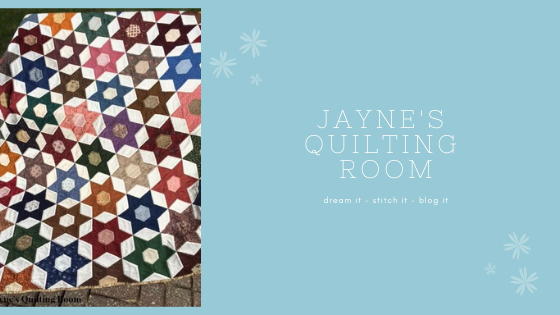I am going to try my hand at a tutorial. Let's see how this goes.
First, you prepare your quilt and your binding as you normally would. I prefer to cut my binding at 2 3/8", but every quilter has her own preference. Fold and press; be sure that the binding is 12-15" longer than necessary. You MUST have this extra in order to make meeting the ends an easier task.
The picture above shows where I began stitching the binding to the quilt (on the right) and where I stopped (on the left). I laid a ruler there to show that you need several inches of space in which to work. Yes, when you get to this point, you have to take it out of the machine, and head to the ironing board.
When you begin attaching the binding, you must make sure to leave a tail of several inches. You will also need to be sure that you'll have a tail at the end. Above, I have roughly an 8" tail on the right, and roughly 12" on the left.
With the edge of the quilt and the edge of the binding lined up straight, I take the tails and fold them to meet somewhere in the middle. See photo above for one side close up.
The other side meets it and is folded back. Press these folds to get a good crisp fold mark. You need to be able to find those fold marks when the binding is opened up in the next step.
I hope you can read the text I added to the picture. Basically, you need to match the folds, right sides together and stitch on the fold line. Cumbersome work, as this means carrying the whole quilt back to the sewing machine and finagling this little bit of binding back under the presser foot. Take your time. If you have given yourself a large enough opening and long enough tails, it will be fine. (Trust me on this - I have tried with small openings and short tails - not fun!)
The photo above shows what this should look like, although to be honest, I think I am off a bit to the left of the fold line. (I probably fixed it after I took the picture.)
Next, it needs to be trimmed up. Keep a quarter-inch seam allowance.
Press it back into shape. I like to press the seam allowance open, then fold over the binding and press again. Now the binding is connected end-to-end, and is ready to have this final bit sewn to the quilt.
If all has been done properly, the binding fits exactly to the unsewn part. Lay the binding along the edge of the quilt, return to the machine and finish attaching to the quilt.
Voila!! You have now successfully attached your binding and even if it does require a few extra steps, it looks perfect when completed.
Do let me know if this tutorial was helpful. I have not done many, but I would consider doing more, if I thought I could help out sometime. If any step needs further explanation, just let me know.
I will be linking to Let's Bee Social over at Sew Fresh Quilts. Go check 'em out!
Added later: a couple of the comments left below offer very good tips that I never thought to add. Be sure to review those, if you don't have a set method of binding. Also, the quilt used in this tutorial was Bradford Star which is being sent to my brother-in-law and his wife in Florida. And, last, I am also going to link this up with Crazy Mom Quilts for her Finish It Up Friday link party. *thanks!*
Happy Quilting, Friends!











Great tutorial Jayne! I often use this method and can offer two additional tips to perhaps ease the way even further. First, after pinning the tails to get them ready for stitching, I take the quilt edge between the tails, fold it in half along the edge and pin or clip it together. I find this reduces the "drag" when I finagle the binding under the presser foot. Second, after pressing the finished seam on the binding tails, I check the fit against the quilt edge before trimming the binding seam allowance. It's really impossible to fix an improper measurement once you've trimmed that safety net away. Ask me how I know :-).
ReplyDeleteWonderful way of doing it! Mine are always a little bulky because I nest the one end in the other, then fold up and sew.
ReplyDeleteThanks for this!
ReplyDelete